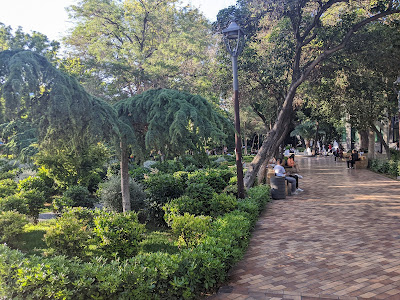Just arrived in Azerbaijan, Baku, it's a beautiful city. During this post, I'll share some observations of the flora throughout the city and highlight a few of the many beautiful parks and areas around the city.
Given that Baku has a semi-arid climate receiving very little annual rainfall and practically zero during the summer months, it is a remarkably green city. The surrounding area is primarily barren with less than 0.5 percent of this territory covered in trees, as you can see from google maps below. This is predominantly due to climatic factors however there are ongoing efforts to regreen the region using a selection of native plants, with a planned planting of 30 million trees.
The city relies on a network of reservoirs and lakes within the region to store and distribute water for various purposes, including irrigation for green spaces
The Kura River, which flows through the country provides the bulk of water for irrigation in agricultural areas and has in the past been diverted to supply water for parks and green spaces in Baku. More recently wastewater treatment plants treat and purify used water, making it suitable for non-potable purposes like irrigation.
The inclusion of native pines Pinus eldarica and Pinus kochiana along the Boulevard are well balanced with exotic and native deciduous broadleafs with topiary and flowers in the understory planted into lawns that are peppered with patches of Trifoilum spp. and Lotus corniculatus
 |
I'll end the post with a photo of the exquisite Albizia julibrissin - Silk tree. Native to this part of the world and featured in the city plantings Baku. I'm really looking forward to visiting the wild stands over the next few weeks. Other wild trees I'll be looking out for include Caucasian Alder (Alnus subcordata) - Caucasian Persimmon (Diospyros lotus) - Caucasian Wingnut (Pterocarya fraxinifolia)
Regenerative Landscape Design - Online Interactive Course
Want to learn how to design, build and manage regenerative landscapes? Join us on our Regenerative Landscape Design - Online Interactive Course. We look forward to providing you with the confidence, inspiration, and opportunity to design, build and manage regenerative landscapes, gardens, and farms that produce food and other resources for humans while enhancing biodiversity.
You can find the course details here and at the moment we have a $350 ( 20%) discount for full enrollment to the course. Just use RLD2024 in the promo code section of the registration form to receive your discount.
Support Our Project
If you appreciate the work we are doing you can show your support in several ways.
Become a member of the Bloom Room. A $70 annual or $7 per month subscription to our Substack provides you with access to live sessions, design tutorials, a members forum and more, see details here.
Make a purchase of plants or seeds from our Nursery or Online Store
Joining us for one of our Practical Courses or Online Courses
Comment, like, and share our content on social media.
If you appreciate the work we are doing you can show your support in several ways.
Become a member of the Bloom Room. A $70 annual or $7 per month subscription to our Substack provides you with access to live sessions, design tutorials, a members forum and more, see details here.
Make a purchase of plants or seeds from our Nursery or Online Store
Joining us for one of our Practical Courses or Online Courses
Comment, like, and share our content on social media.


























.jpg)




Great post! Baku’s parks and street trees really show the city's natural beauty. If you're planning to explore more of Azerbaijan, consider checking out Azerbaijan Tour Packages to experience even more of the country's stunning landscapes and rich culture!
ReplyDeleteIndulge in a luxurious travel experience with DHT Holidays' Azerbaijan tour packages. Whether you're captivated by the modern cityscapes of Baku or yearning to explore the rugged beauty of the Caucasus Mountains, our expertly crafted itineraries cater to every traveler's dream. Book now and let us take you on a remarkable adventure through Azerbaijan.
ReplyDeleteThis is such an informative post! Planning a corporate trip can be challenging, but finding the right partner makes all the difference. I’ve been exploring different Travel Companies in Baku, and it’s great to see how many of them now offer customized packages for business groups, including team-building activities and cultural experiences.
ReplyDelete